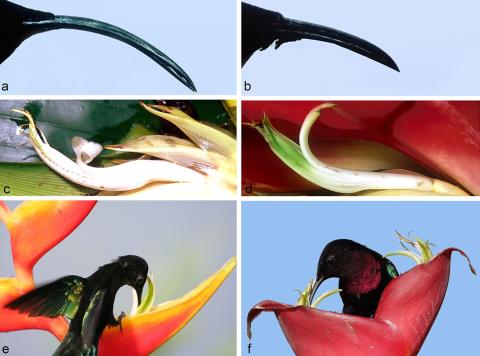"Floral isolation and pollination in two hummingbird-pollinated plants: the roles of exploitation barriers and pollinator competition"
Temeles, E.J., Liang, J. '17, Levy, M. C. '15, and Y-L Fan.
Evolutionary Ecology, 2019, 33:481-497
We show that floral isolation between sympatric Heliconia caribaea and Heliconia bihai on the island of Dominica, West Indies, is maintained by exploitation barriers and interference competition. In experiments with captive birds, we found that both short-billed male and long-billed female purple-throated carib hummingbirds are able to pollinate the two heliconias and transport pollen between them. Male purple-throated caribs, however, were unable to remove nectar from 88% of the Heliconia bihai flowers they visited, and could only remove nectar from the shortest Heliconia bihai flowers. Female purple-throated caribs, in contrast, were excluded from Heliconia caribaea through interference competition with larger, territorial males. As a result of these mechanisms, pollen transfer between the two Heliconia species was virtually absent in three sympatric populations.

Fig. 1 Bills of female (a) and male (b) Anthacothorax jugularis, flowers of H. bihai (c) and H. caribaea
(d), and feeding positions of female A. jugularis at H. bihai (e) and male A. jugularis at H. caribaea (f).
a–d Modified from Temeles and Kress (2003)

Fig. 2 Placement of pollen on bills and crowns of male (solid circles) and female (open circles) purplethroated
caribs (number of pollen grains, mean ± SE) after visits to flowers of H. caribaea (a) and H. bihai
(b). Ranges on X-axis refer to distances (in mm) from bill tip. Significant differences between the sexes are
indicated by asterisks (*P < 0.05; t tests)